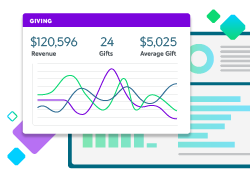Engaging Your Donor Community: 5 School Fundraising Tips

Fundraising is often a necessity for schools to provide students and teachers with resources that set them up for success. Planning and implementing school fundraisers can involve a lot of work, but that doesn’t mean they have to feel like a chore. When done well, fundraisers can become beloved annual events that your community looks forward to year after year.
How do you turn a standard campaign into a fundraiser your community will love? Simply focus your attention on donor engagement. Whether you’re ready to jump back into in-person fundraising or would rather host a virtual event-free fundraiser, you’ll need tools in place to keep donors’ attention and motivate them to give..
When you prioritize creating an impactful experience for your donor community, you’ll keep donors coming back and raise more funds for your school.
In this article, we’ll go over each of these tips in detail so you can better engage your school’s donor base:
- Intentionally target your audience.
- Choose a fundraiser that educates students.
- Consider using software to simplify the donation process.
- Promote your fundraiser across multiple platforms.
- Celebrate students by offering prizes.
High schools will naturally need different approaches than elementary schools, so be sure to tailor each strategy to your school’s specific needs as we explore these tips.
1. Intentionally target your audience
The first step to engaging with your supporters is to define exactly who your audience is. Think about the people who make up your community of donors. Is it mostly parents or neighbors? What about students’ extended families?
Don’t assume that your audience will always stay the same. Just as your student body changes year by year, so might your donors. Keep up to date with the most current donor information you’ve collected to ensure you’re targeting the right audience. Use recent campaign data to determine who your donors are, then find out which kinds of campaigns they’ve engaged with most in previous years.
Along with using data from previous campaigns, analyze your donors’ demographics, such as age group and average income. Based on all of this information, determine what kinds of events your supporters would want to participate in. For example, supporters who are parents often like fundraisers they can participate in with their children.
Another helpful factor to keep track of is donors’ preferred communication methods. You can determine these by analyzing metrics like email open rate and social media engagement, or you ask supporters directly in a survey.
2. Choose a fundraiser that educates students
By donating to your school, every donor makes a deliberate investment in your students’ education. Since you know that your supporters are passionate about improving student learning, why not build an educational aspect into your fundraiser?
Educational fundraisers align with your audience’s values and remind your donors why they should support your school.
By choosing an idea that raises money and educates students at the same time, your community will want to be more involved. Here are a few ways you can incorporate education into your fundraiser:
- Read-a-thons. According to Read-A-Thon’s list of top school fundraisers, these reading challenges raise an average of $8,500 even if only 50% of students participate. Students log reading hours, and families and community members sponsor their participation by donating. With this fundraiser, you’ll raise money and get students excited about reading.
- Trivia nights. Parents and students alike can participate in this exciting event, either individually or on teams. Combine educational topics with pop culture trivia questions, and consider giving out prizes for the winners.
- School book fairs. Book fairs are always a favorite with students! Partner with a book fair company to sell new books to students, and your school will get a percentage of the profit from sales.
- Movie nights. There are plenty of movies to choose from that can be educational and fun for students and their whole family.. Host an in-person movie night or a virtual watch party and charge a fee for tickets to raise funds..
Any of these ideas can be adapted for different age groups, grade levels, and student preferences. Choose a fundraising idea that works for your school’s needs, or come up with your own educational fundraising idea!
The Nonprofit CRM Built for Fundraisers
Find out how Blackbaud’s Raiser’s Edge NXT® fits your organization.

3. Consider using software to simplify the donation process
Once you’ve chosen a fundraiser with your donor community in mind, think about ways you can simplify the donation experience. You can use specialized fundraising software to provide donors with a smoother overall experience.
Re:Charity’s list of top fundraising software solutions showcases the wide variety of resources available, such as:
- Event management software. To keep better track of your events, you can use software to manage ticket sales, create registration pages, and track data.
- Peer-to-peer fundraising platforms. If you’re planning a fundraiser that involves students or parents collecting donations on your school’s behalf, you can invest in a peer-to-peer platform to host each participant’s campaign page in the same system.
- Online donation processing tools. Online donation platforms have features such as customized donation forms and text-to-donate. Use these tools to accept payments securely online and optimize the process for donors.
Fundraising software can lessen the demands on your school and make it easier to effectively collect data. Research options that make sense for your school’s needs, and focus on optimizing the donation process for your donors so they’re more likely to give.
4. Promote your fundraiser across multiple platforms
To maximize attendance, promote your fundraiser across many different platforms to reach parents and extended family members more easily. Use the information you gathered earlier about your donors’ demographics and preferences as a guide for communications that target your school’s specific audience.
For example, younger parents may favor Instagram, while students’ older family members are more likely to respond to fundraising announcements on Facebook.
Meet your donors where you know they’re already spending their time, using a mix of platforms like:
- Email. Fundraising email campaigns are effective for general announcements, progress updates, and event reminders. With compiled donor email lists, you’ll be able to reach out to all of your previous donors and add new donors to the list easily.
- Social media. Use school or PTA accounts on several different social media platforms for the widest reach. Encourage parents and donors to follow your accounts and share fundraising announcements. Don’t forget to respond directly to comments and questions on your pages.
- Flyers. If a large number of your donors are parents, one of the best ways to reach them can be simply sending announcement flyers home with your students. You can also ask local businesses to post flyers in their establishments to reach the wider local community.
In your promotional materials, be sure to give concrete details that explain exactly where the money is going and who will benefit—your students.
5. Celebrate students by offering prizes
You can encourage students to participate and be more engaged in educational fundraisers by offering prizes. With the right incentives, students will be excited to get involved in these learning opportunities outside of the classroom, and donors will be equally happy to see the positive impact of your fundraiser on students.
You can offer prizes for everyone, for the top fundraisers, or for participants who reach certain milestones. School fundraising prizes can be anything that will get students excited about participating. Some great options include:
- Small toys
- Fun school supplies
- Books
- Gift cards
- Pizza parties
- Field trips
Ask your students which prizes they’d prefer ahead of time by giving them a survey or presenting prize options during morning announcements. To get students even more excited about the fundraiser, host a pep rally or fundraiser launch at the beginning to introduce all of the prizes.
With these five tips, you’ll be able to create fundraisers that engage students, parents, and your wider donor community. Combine these strategies with other resources like fundraising checklists to ensure you’re targeting your audience in the most effective way possible.
